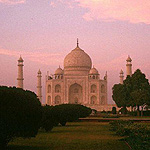
THE TAJ MAHAL

The Taj Mahal is one of the most beautiful masterpieces of architecture in the world. It is Located at the city of Agra in the State of Uttar Pradesh. It was the Capital of the Mughals (Moguls), the Muslim Emperors who ruled Northern India between the sixteenth and nineteenth centuries. The Mughal dynasty reached its highest strength and fame during the reign of their early Emperors, Akbar, Jehangir, and Shah Jehan.
It was Shah Jehan who ordered the building of the Taj, in honor of his wife, Arjumand Banu who later became known as Mumtaz Mahal, the Distinguished of the Palace. Mumtaz and Shah Jehan were married in 1612 and over the next 18 years, had 14 children together. The Empress used to accompany her husband in his military campaigns, and it was in 1630, in Burhanpur, that she gave birth to her last child, as she died in childbirth. The Emperor love to his wife was so great that he ordered the building of the most beautiful mausoleum on Earth for her.
Although it is not known for sure who planned the Taj, the name of an Indian architect of Persian descent, Ustad Ahmad Lahori, has been mentioned in many sources. The site was chosen near the Capital, Agra on the southwest bank of the River Yamuna. The actual Tomb is situated inside the Taj.
The unique mughal style combines elements of Persian, Central Asian, and Islamic architecture. Most impressive are the black and white chessboard marble floor, the four tall minarets (40 m high) at the corners of the structure, and the majestic dome in the middle. On closer look, the lettering of the Quran verses around the archways appears to be uniform, regardless of their height. The lettering spacing and density has been customized to give this impression to the beholder. Other illusionary effects have been accounted for in the geometry of the tomb and the tall minarets. Mostly common in Islamic architecture. The level of sophistication in artwork becomes obvious when one realizes that a 3 cm decorative element contains more than 50 inlaid gemstones.
HOME
NEXT PREV.